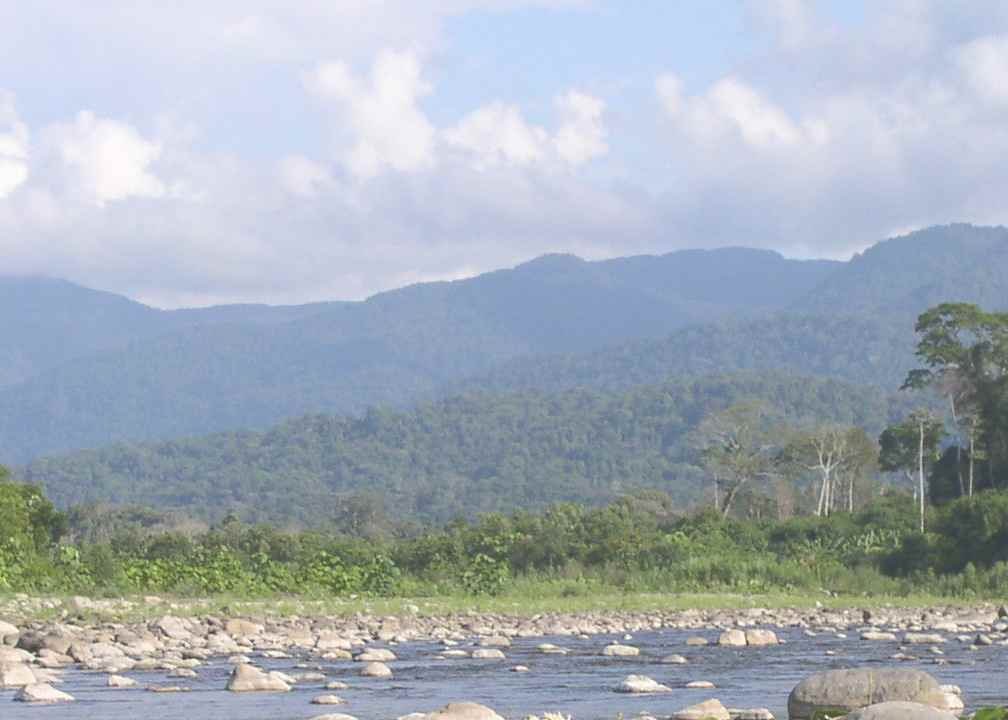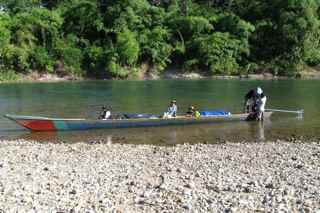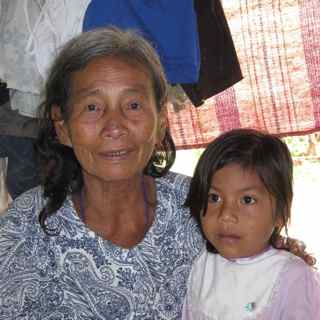 Cabeceras Aid Project
Cabeceras Aid Project Cabeceras Aid Project
Cabeceras Aid ProjectChristine Beier
8 September 2010
Here I am, once again in Iquitos, after a mere six days' adventure on the Napo River. In brief, I found Delia Andi -- and at that same moment, I found out that she was waiting right there on the beach to catch the next riverboat down to Iquitos. Ay! What else could I do but follow her back to the city?!
Now, in greater detail... I made my way, as planned, to Santa Clotilde via rápido (see previous post) last Thursday. That same day, I was able to arrange transportation for the next day up to Delia's island home near Puerto Elvira via pekepeke -- by luck, a relatively large, and therefore faster, 13HP motor. I set off first thing on Friday, traveling almost twelve hours that day, and then traveling five more hours on Saturday morning, before finding the right house on the right island. As luck would have it, Delia herself was sitting right there on the beach when I pulled up to greet her at about 11:30a on Saturday. Awkwardly enough, though, she wasn't actually glad to see me, since she herself was anxiously waiting to board the riverboat 'Cabo Pantoja' as it passed by on its bi-monthly journey down to Iquitos from the town of Cabo Pantoja (near the border with Ecuador). This trip, which she undertakes only once or twice a year, is, for good reason, no small event for her, and therefore my arrival was, at least initially, more distressing than anything else.
None the less, she realized that I had come a very long way just to see her, and so I she agreed to talk to me for a little while. Sitting together for about an hour up at the house, I gave her copies of all the photos that Lev had taken, as well as a few copies of the wordlist Lev had collected, and she relaxed a little bit, enough for us to agree that I could travel downriver on the Pantoja as well, and then we could work together on language documentation once we arrived in the city. During that hour, she had me read to her a few of the pages of a'éwa that I'd typed up, and she found several errors, so I think her desire to see the work done well kicked in (as I hoped it would) despite her apprehensions about the logistics of it. She insisted, though, that I wait for the Pantoja back in Puerto Elvira, since she was busy preparing for her own journey. I gladly respected her wishes, and had 'my' pekepeke dropped me off at the main port in Elvira (such as it is) on its way back to Santa Clotilde. Luckily, I was able to spend the night at the house of Profesor Raul, one of Puerto Elvira's three school teachers; he said he remembered Lev from 2008, and he and his whole family were very friendly and helpful to me. He even accompanied me to the community's new satelite telephone (!) and we were able to ascertain that the Pantoja wouldn't arrive until the next morning, so I was able to set up my tent and sleep without worrying if the boat would arrive and catch me unprepared.
I boarded the Pantoja at about 6a on Sunday, and off we went on our three-day journey back down to Iquitos. Run by the municipality of Torres Causana, the Cabo Pantoja is a lumbering three-deck cargo-and-passenger riverboat that constitutes the principal means of connection between Iquitos and all of the settlements along the Napo River up to the border with Ecuador. When I boarded, the Pantoja was already quite full of people from points upriver, and we traveled stopping frequently, as the riverboat continued to fill up with countless plátanos, chanchos, búfalos, and passengers. It had taken the Pantoja 12 days to travel up to Cabo Pantoja from Iquitos, because the river is so low right now -- in fact, another passenger told me, twice the boat had run aground and all the men had had to get out and push it off the sandbar! As a result, there was a backlog, so to speak, of people and their cargo waiting to travel down to Iquitos. I hadn't brought a hammock, since I had no idea I'd find myself traveling on a riverboat, but I was able to pitch my tent on the top deck, so I was actually quite comfortable. We didn't travel at night on either Sunday or Monday, because the river is so low, but we did travel all night last night, and thus we arrived in Iquitos before 5 this morning.
For her part, Delia traveled on the second deck, accompanied by her grandson Ginmer, and she basically never left her hammock. She explained that she was uneasy about being surrounded by so many strangers -- although, in fact, she knew many of the other passengers, or their mothers or grandmothers. I visited her intermittently throughout the journey and we chatted and got acquainted a bit. She told me a bit about her family and a bit about her youth; she clearly remembers her childhood as time of slavery for local people in the patrón/peón system. Proud none the less of her indigenous heritage, she doesn't approve of the fact that I don't speak Quichua! Not surprisingly, the second deck of the Pantoja was a terrifically loud environment, so our communication was, on the whole, quite spare. But as we traveled, she relaxed a bit and warmed up to me, and she gradually became quite enthusiastic about working with me here in the city. For all of her 72ish years, she has a very sharp mind, and I could tell that she had calculated out the advantages of working with me -- among other things, I had pointed out that I would pay her as a language consultant, and I'm sure she realized that working with me would be very much to her benefit, and really have very few disadvantages, if any. For my part, working with her here in the city has advantages, too, including electricity and the opportunity to print up a bigger and better wordlist for her once we've finished working together.
Once we arrived at the port of Masusa here in Iquitos this morning, her grandson Ginmer and I hopped in a mototaxi and he showed me the house where they'll be staying while in Iquitos. Luckily, it is quite near Masusa, so I'll have no trouble finding it again when I meet with her on Friday morning. Delia explained to me that she wants to deal with various matters as soon as she arrives, but I am welcome to visit her on Friday, so we've got an appointment for 9am. She told be going back home again on the Pantoja, but it will be here in Iquitos for 15 days, so I should be able to work with her for 5 or 6 days, I dearly hope, before my departure for Lima on September 15th.
I've decided that between now and 9a Friday, I'm going to learn some Quichua -- at least a few words, to please her. Quichua is clearly the language that she really 'lives' in; moreover, she said to me several times, Quichua ''es lo más fácil'' (''the easiest of all'') so I really don't think she respects my inability to speak it! And, in the bigger picture, there's no doubt in my mind that learning some conversational Quichua is imperative if I'm going to spend any time in the future in the remoter parts of Loreto, so I might as well start now...
Christine Beier
8 September 2010
 As glad as we were that Lev actually found Maria Cabloy in June, we were equally unglad that she remembered so little of the language of the a'éwa people. As a result, a return visit to Delia became even more urgent. Indeed, making the trip to visit Delia on the Alto Napo was one the principal motivations I had for extending my stay in Peru until October. So after a brief rest for me in Iquitos, Lev and I put our minds to making that trip happen (no time for rest for Lev, though, with the semester beginning, pobrecito!).
As glad as we were that Lev actually found Maria Cabloy in June, we were equally unglad that she remembered so little of the language of the a'éwa people. As a result, a return visit to Delia became even more urgent. Indeed, making the trip to visit Delia on the Alto Napo was one the principal motivations I had for extending my stay in Peru until October. So after a brief rest for me in Iquitos, Lev and I put our minds to making that trip happen (no time for rest for Lev, though, with the semester beginning, pobrecito!).
For his part, back in Berkeley Lev scanned and sent to me PDFs of all the existing documentation of so-called Vacacocha. For my part, I listened to recordings of Lev's work with Delia in 2008; and I compiled a spreadsheet of all the data from these historical documents (Tessmann 1930/1999, Espinosa 1955, and Villareal 1959 [?]) plus the data Lev had collected from Delia Andi in 2008 and from María Cabloy in June of this year, to use as stimuli with Delia during my visit. My plan was to take a 'rápido' (basically, a river 'bus' with a high-powered outboard motor) to Santa Clotilde on the lower Napo River, and then travel two days by pekepeke (a long-shafted, low-powered motor, ubiquitous in Amazonia; see photo) to Delia's home near Puerto Elvira on the upper Napo. Once there, I planned to spend seven days with her, encouraging her memories of the language of her childhood. Thereafter, I would arrange for transportation, again via pekepeke, back to Santa Clotilde. Thus was the plan, anyway; see next post.
Christine Beier
8 September 2010
As described below in Lev's post, in 2008 we learned the names of two of the last remaining rememberers of the language of the a'éwa people. This language is known by outsiders by several names, including Vacacocha, Awshiri, and Abishira; see Fabre 2005 and Ethnologue, for example. In 2008, Lev was able to work for two days on language documentation with one of these rememberers, Delia Luisa Andi Macahuachi, who lives on the Alto Río Napo (again, see below). The other rememberer, María Cabloy, is a relative of Delia's, but Delia told Lev that María now lives on the Momón river, quite far from the Alto Napo. Delia spoke of María as knowing as much as, or perhaps more than, she herself remembers, so we had high hopes of being able to work on language documentation with both women in future years.
In 2009, neither Lev nor I had no time to track down María, as much as we wished to do so. This year, however, thanks to the unpredictable nature of travel planning in the jungle, Lev found himself alone in Iquitos with a few free days at the beginning of June -- and so he went in search of María on the Momón. His adventure unfolded in a similar manner to his quest for Delia in 2008: with just a name in hand, he headed up the Momón, stopping at various little settlements and asking questions, until he finally arrived at the house of María herself.
Alas, it turns out that María, who is quite a bit younger than Delia, remembers very little of the language and was able to produce very few words. She did, however, recognize most of the words that Lev had collected from Delia and was able to confirm most of their glosses. The most solid result of Lev's work with María was the knowledge that our best hope for documenting this unique language lies with Delia on the Alto Napo.
Lev Michael
August 3, 2008
 In an earlier post I outlined my plans to do some exploratory work this summer on Andoa, a minimally documented Zaparoan language spoken on the Rio Pastaza, near the Peru-Ecuador border region. As I was preparing for my trip to the Rio Pastaza, however, some of my travel arrangements fell through, and it became apparent that I would not be able to make it to the Andoa community in the time I had available. Fieldwork on Andoa would have to wait until next year.
In an earlier post I outlined my plans to do some exploratory work this summer on Andoa, a minimally documented Zaparoan language spoken on the Rio Pastaza, near the Peru-Ecuador border region. As I was preparing for my trip to the Rio Pastaza, however, some of my travel arrangements fell through, and it became apparent that I would not be able to make it to the Andoa community in the time I had available. Fieldwork on Andoa would have to wait until next year.
I thus found myself in the lovely city of Iquitos with a free week on my hands. Perfect, I thought; this would be an opportunity for me to see if I could find any speakers of Vacacocha. Now, if you haven't ever heard of Vacacocha (also known as Aushiri), you are not alone. It is among the most poorly documented of Peruvian Amazonian languages, and the language is known only from a few short word lists, none of them collected by trained linguists (a bibliography of Vacacocha references is available here (pdf)). Based on this limited information, the language is considered by most classifiers to be a linguistic isolate, but for the most part, so little is known about the language that it tends to elude linguists' attention. The one clue about where to locate speakers of Vacacocha, repeated in many sources, is that in the early 20th century, there were several families of Vacacochas in a place on the Rio Napo known as Puerto Elvira.
Two days later, then, I found myself on the Rio Napo with a theoretical destination and a general direction to head in -- upriver. After two more days' travel up the Napo I pulled into Puerto Elvira, a community of about 200 people, situated on a bluff overlooking a majestic bend in the Rio Napo. Shortly after touching down I was shuttled over to the community's three school teachers, who politely asked me what I was doing in their community. After I explained that I was looking for speakers of Vacacocha, the teachers put their heads together and came up with some recommendations for whom I might speak to.
I spent the remainder of the afternoon shuttling back and forth between various little islands upriver of Puerto Elvira, following up on suggestions about where older individuals with some knowledge of Vacacocha might be found. Eventually I met Delia Luisa Andi Macahuachi (see photo above), a slight woman of some 70 years, who explained that she spoke Vacacocha as a child, and had used it intermittently as a young adult, but had not spoken the language in several decades. She expressed willingness to work with me, however, to document anything she could remember.
It very quickly became apparent that the language is tonal -- in fact, shortly after beginning the first elicitation session, Delia reprimanded me for repeating the words with a flat intonational contour, and I subsequently paid more attention to carefully reproducing the tone contour of the words. Also obvious is the fact that the language has a contrast between oral and nasal vowels. Neither the tonal nature of the language nor the oral/nasal contrast is mentioned in the available material on the language, so it became clear that even if I were only able to collect lexical data, it would be possible to significantly improve linguists' knowledge of this isolate.
From what I was able to determine, Delia is the only remaining individual in the Puerto Elvira area with any significant knowledge of Vacacocha. During the two days I was with her, Delia worked hard to remember aspects of the language she had not used regularly in close to sixty years. Although she initially found the work frustrating, she came to find the exercise of recovering long-dormant parts of her knowledge quite gratifying. I promised to return to her at the earliest opportunity a copy of all the words and phrases I was collecting from her, and she was especially excited about the idea of leaving the linguistic documentation as a legacy for her grandchildren.
Delia and her family members mentioned another relative who they considered to be the best and sole other remaining speaker of the language. Unfortunately, this other speaker was taken several years ago by her children to live on the Rio Momon, near Iquitos, and I did not have the opportunity to work with her. I hope to locate her next year.
After two days, I had to return back downriver, as I had other pending fieldwork obligations. I was quite excited, however, to have found at least one semi-speaker with who I could work to recover aspects of Vacacocha phonology and lexicon, and I am looking forward to returning next year to make some further progress.
 Last updated: 17 November 2010
Last updated: 17 November 2010